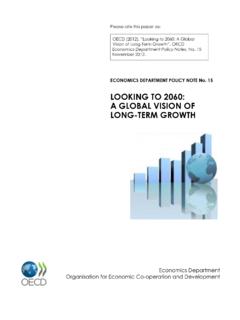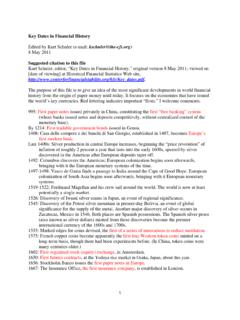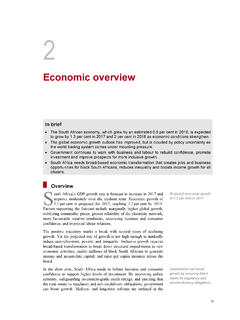Transcription of GLOBAL TRENDS AND FUTURE CHALLENGES FOR …
1 APRC/12 /INF/10. GLOBAL TRENDS AND FUTURE CHALLENGES FOR. THE WORK OF THE ORGANIZATION. WEB ANNEX. Contextual TRENDS and macro elements GLOBAL TRENDS : Trend 1: Food demand is increasing while patterns of food consumption are changing towards more livestock products, vegetable oils and sugar Trend 2: Growing competition and diminishing quality and quantity of natural resources and loss of ecosystem services Trend 3: Energy security and scarcity the landscape and TRENDS Trend 4: Food price increases and price volatility Trend 5: Changing agrarian structures, agro-industrialization and the globalization of food production Trend 6.
2 Changing patterns in agricultural trade and the evolution of trade policies Trend 7: Climate change will have a growing impact in agriculture Trend 8: Science and technology as a main source of agricultural productivity and production increases is progressively is becoming a private good and the processes are dominated by the private sector Trend 9: Evolving development environment: increased recognition of the centrality of governance and a commitment to country-led development processes Trend 10: Increased vulnerability due to natural and man-made disasters and crisis CONTEXTUAL TRENDS AND MACRO ELEMENTS.
3 Introduction 1. This section contains a description of TRENDS that are external to the GLOBAL food and agriculture economy, but that will directly influence the development of it. 2. While agriculture, fishery and forestry tend to reduce their relative size in the economy as countries experience economic growth and income increases, their degree of integration with other economic activities tends to increase. Primary production activities become less isolated, and more exposed to the opportunities and the vagaries generated in other sectors, from technology, to services, to price volatility. A similar dynamic seems to operate across space: trade investment and, more broadly, indicates and increased degree of osmosis among countries and distant regions.
4 As it happens within the economy this builds up both opportunities and potential tensions among heterogeneous stakeholders. Countries and regions where agriculture is still the backbone of an undifferentiated economy are increasingly exposed to complex demands, and the competition of far away primary production systems. 3. In discussing external drivers of agriculture, fishery and forestry, we take the evolution of the macro economy and population as starting points. These variables pave the way to describe other wider TRENDS , including changes taking place in technology, society as well as the environment in which we live, and the associated risks.
5 This section contains a description of TRENDS that are external to the GLOBAL food and agriculture economy, but that nonetheless are likely to have a significant economic and political influence in the way agriculture and food production develops. It assumes the evolution of the macro economy and population dynamics as starting points to describe other wider TRENDS . Population dynamics 4. The dynamic of population is usually assumed to be exogenous, while in fact it is affected (and affects) economic performance and other key variables. Data from the latest UN assessment (2010) under the medium fertility variant indicates that population is expected to reach billion in 2050, and to continue growing at decreasing rates until the end of the century.
6 Population (millions). 12000 10000. 8000. millions 6000. 4000. 2000. 0 1950. 1955. 1960. 1965. 1970. 1975. 1980. 1985. 1990. 1995. 2000. 2005. 2010. 2015. 2020. 2025. 2030. 2035. 2040. 2045. 2050. 2055. 2060. 2065. 2070. 2075. 2080. 2085. 2090. 2095. 2100. developed Sub-Saharan Africa NothAfrica and the Middle East Latin America and Caribb South Asia Eastern Asia percentage annual growth rate (right scale). Source: United Nations, Department of Economic and Social Affairs, Population Division, 2011. 5. Virtually all the population increase is expected to take place in developing countries. Developed countries will start declining in the late 2040s.
7 By 2100, the only region where population is still expected to be growing is sub-Saharan Africa, which will have reached some billion. Projections for certain African countries show particularly fast increases, reaching up to to 7 times their current levels at the end of the century. 2. 6. Moreover, world population is changing in several ways. One aspect worth emphasising is ageing: the proportion of persons aged 60 years and more is bound to increase in the world as a whole. This process, however, is advancing at a faster pace in developed countries albeit with differences - compared to developing countries.
8 7. The age composition and the speed of the aging of a population affect its dependency ratio, which is the number of dependent individuals -- younger than 15 and older than 64 -- per working age adult. This indicator is notoriously related both the growth potential (negatively) and the prevalence of poverty (positively). Age composition and dependency ratios Source: Anriquez and Stloukal, 2008. 8. Most of the population increase which is expected to take place over the next decade will be concentrated in urban areas, especially in developing countries. Rural-urban migrations will likely remain by far the most important component in terms of population movements, mostly driven by income differentials.
9 About 67 percent of world's population is expected to be concentrated in urban areas by year 2050. Urban dwellers tend to change consumption habits, and consume more manufactured goods and service, while increasing the amount of good that they purchase from specialized producers, as opposed to what they produce within the household. Population (billions). billions 1950. 1955. 1960. 1965. 1970. 1975. 1980. 1985. 1990. 1995. 2000. 2005. 2010. 2015. 2020. 2025. 2030. 2035. 2040. 2045. 2050. Rural Urban Source: United Nations, 2009. 9. The evolution of world population, given the above picture, may also contribute to a shift of importance towards today's emerging economies.
10 The higher proportion of working age adults is historically correlated to high growth potentials, both from the supply side, given the higher availability of manpower, and from the demand side, given that younger populations tend to consume more and higher quality products. 10. Population growth, ageing and urbanization affect consumption - and food consumption - habits through different channels, as well as the development of agrifood production activities. 3. GLOBAL financial crisis , economic growth and poverty 11. The current macroeconomic outlook is characterized by a high degree of uncertainty. The GLOBAL financial crisis is having a profound impact on real economies in key countries of the OECD, which have recently undergone a downturn, and may undergo an even deeper recession in the coming years.
















